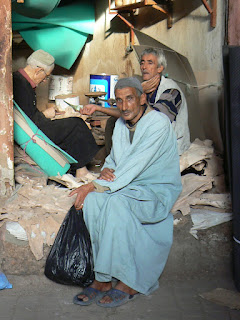Our two-hour easyJet flight from Madrid brought us to Marrakech where we woke up this morning to the Call to Prayer coming from the mosque near the Dar Maria, a little riad tucked into an allley in the medina where we'll be staying the next few days.
The bus from the airport let us off in the Jemaa El Fna, above, the main square and a thousand-year-old gathering place that fills up with orange juice vendors, date sellers and snake charmers by day, and a big, smokey outdoor market at night with hundreds of outdoor food stalls, story tellers and henna tattoo artists.
Just outside this square is as far as cars can go. From here, it's all narrow streets, wide enough for donkey carts and motorcycles and people like us, rolling suitcases, trying to find their hotels. Young boys build whole businesses out of helping lost people find their way. Tom did an amazing job of using a compass and several maps to get us pretty close, but with no signs or markers and lots of little alleys leading everywhere, it would have been impossible to find the exact alley to turn into without help. Three guys offered all at once,
but it was worth the going rate- 75 cents to $1 or so - considering most people take up the hotel on an offer for an airport pick up for $20. Above is the open-air courtyard. Surrounding it are a few small rooms. Breakfast is served on the rooftop terrace with wide view of the town and surrounding Atlas Mountains. The riad is owned by a Spanish woman named Maria and friendly and helpful staff who gave us advice on important details such as how much to pay for a bottle of water (everything is negotiable) or a taxi ride.
Shops and workshops are arranged in the souks according to what the vendors or craftsmen produce or sell- everything from wool hats to leather bags, hammered copper and tin, jewelry and nuts and spices.
These pictures were taken in the the "skinners'' souk where raw animal hides are sold. The blue foam is used as wrapping paper. The man below in black is the shopkeeper. With him are two of his customers. The man in the foreground held up five fingers when I asked him if I could take this picture, indicating he wanted a 5 dirham "donation,'' the equivalent of about 75 cents.










No comments:
Post a Comment